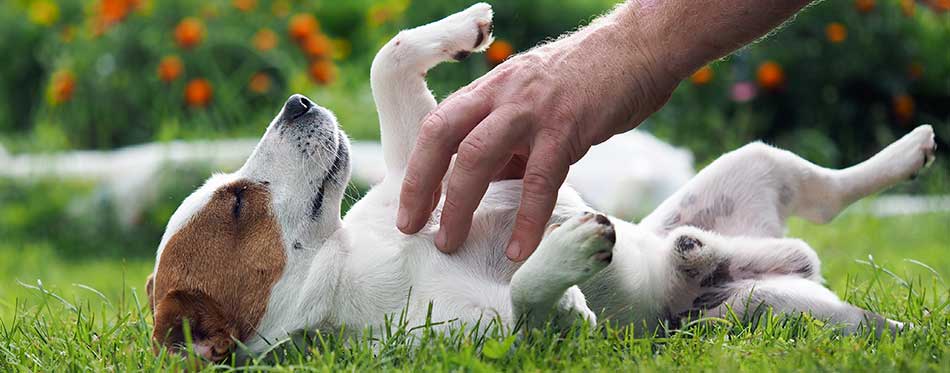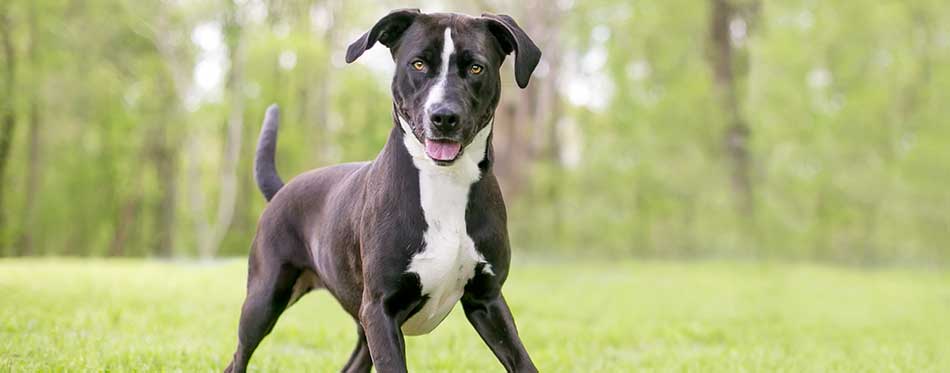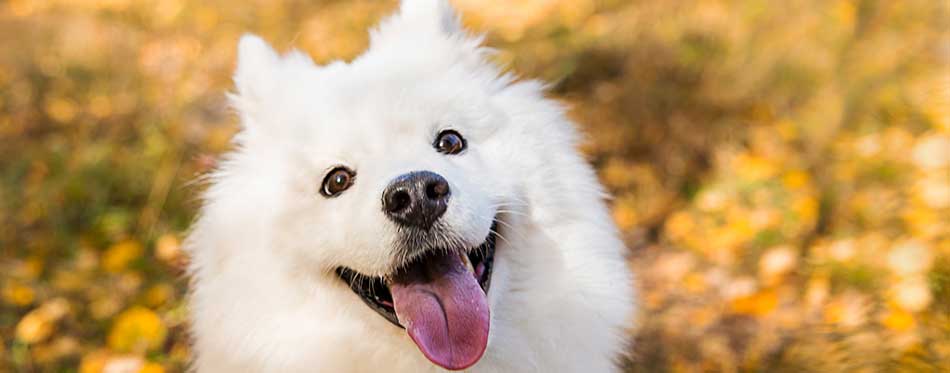What an absolutely joyful concept! Dogs laughing while being tickled by their dog owners, being given belly rubs, or being scratched in that sweet spot. Many dog owners wonder if the sound they heard during more physical playtime and teasing is their dog laughing, and we’re here to tell you that it very well could have been! Some dogs are more sensitive than others, so come along on this belly-busting journey and find out if what you’re doing is making your dog laugh in its way.
Are Dogs Ticklish Anywhere?
Dogs can be ticklish, but their ticklish spots will depend on the dog. You can try some common ones, but just like tickling humans, not every spot you try will work. Furthermore, dogs have different sensitivity levels, and what may cause one pup to have a tickle response may cause another to get mad at you or just confused.
The tickle response is called “gargalesis”. Gargalesis is found in humans, primates, rats, and even dogs. This response to physical stimuli leads to a tickling sensation, making dogs react by laughing, trying to get away, or even kicking their leg.
In some circles, people are unsure whether dogs experience tickling. One theory is that they experience knismesis instead, a light, feather-like sensation that does not end in laughter. Instead, it feels more like you need to scratch your skin or have some skin irritation.

How to Tickle a Dog
To tickle a dog, first, you need to understand how we define ticklish. Dogs will respond to a lot of sensations, and what they find ticklish when touched may look like they’re twitching to the human eye. Get familiar with how your dog expresses that they enjoy a sensation, including the breathy sound that we can recognize as laughter.
To tickle a dog:
- Choose a spot that you know your dog enjoys having scratched or petted.
- Lightly scritch at that spot with your nails or rub with your fingers and hands.
- Watch for your dog’s reaction to the sensation.
- Try different pressures with your nails or hands to find out what your pup likes best in that spot.
- Move on to another area and try again.
Remember that you’re watching for involuntary reactions, breathy sounds, huffing, or a doggy smile. A kicking leg and a grin are some of the best reactions you can get from your canine friend!
Do Dogs Have Tickle Spots?
Dogs do have tickle spots! Many dogs will react to similar tickle spots, you just need to know where they are so you can see which ones cause neurological stimulation in your pup.
As we mentioned earlier, tickling a dog isn’t any different from tickling a human. To make your dogs laugh, test out a few different areas that you know have garnered a positive response from your dog before. You may not have even realized that you found a ticklish area on your dog. Look for an involuntary reaction, such as when your dog kicks out their leg while squirming or when they start panting. An involuntary movement or sound is a good indication that you’ve hit an unexpected happy place.
If your dog gets raised hair, growls, or is actively trying to get away from you, stop what you’re doing. The parts of a ticklish dog are vulnerable areas, and not all dogs like being touched there. We wouldn’t advise heavy tickling until your dog is familiar with the sensation, and you shouldn’t try to tickle vulnerable or aggressive dogs.
Find Your Dog’s Tickle Spots
Without a doubt, the best places to try and get your dog to laugh and the same ones that get a happy reaction when they’re pet. Tickling causes a similar reaction to being petted, with the difference being the way you interact with your dog and the sounds they make.
The best sensitive areas on your dog are:
- Behind their ears
- Their neck
- In the pits of their front legs
- Their feet on all legs
- Above their tail
- Along their spinal cord
- Their belly (your pet will adore a belly rub!)
Areas to Avoid on Your Dog
There are certain areas of your dog’s body that you should avoid. These aren’t any dog’s tickle spots and are more likely to cause your dog to show signs of discomfort, anger, or even pain if you’ve touched them too hard.
Avoid:
- Their muzzle
- The inner part of their ears
- Their tail
- Either hind leg
And just in case, we do need to say it: Your dog’s pelvic area. They won’t thank you, and they certainly won’t laugh.
You should also avoid areas of dry skin because you could cause damage to your canine companion while their skin is sensitive.
Not all of these no-go spots will get the same negative reaction. Certain spots, such as the muzzle, are fine on friendly dogs or dogs used to being included in rough play. Learn your dog’s boundaries.

Know Your Dog’s Body Language
Part of learning your dog’s boundaries is to understand their body language. Your dog cannot speak, and they have limited sounds that they can make to help you know them. Like cats and other domestic pets, your pup will give you a sign using their body language, which you will need to decipher.
The Tail
The faster your pups are wagging their tails, the happier they are. But it’s not just a happy motion, and it’s more along the lines of them being so excited that they need to show you. Many people use the word “aroused” to describe this, but that can be misinterpreted.
The long, slow, sweeping motions of their tail signify that they are relaxed and happy.
Twitch-like movements are negative. Your pet could be alert for some reason.
Hackles
What are hackles? You hear the term a lot in this sentence: “My hackles are raised.” This gives you a good indication of what it means, but let us explain:
Your dog’s hackles being raised means that the hair along their back is standing up. This is called “piloerection” and can cause their fur across their shoulders and back to stand on end. In cats, you’re more likely to see their tail fluff up instead. It’s a sigh of high emotion or “arousal”, but it can be negative or positive, which makes it a difficult sign to figure out.
Posture
When their weight is shifted forward, they’re trying to get closer. When their weight is shifted away, it indicates that they want to leave the situation. The signs included in a canine’s posture are easier to read because they’re often accompanied by facial expressions or vocalizations (such as growling).
Dogs hunched close to the ground are scared, while those bowing their front with their bottom in the air want to play. The latter example of posture is a good time to break out the tickles!
Animals don’t typically smile, so you need to rely on your knowledge of their posture to help you figure out what they want. That includes everything from dog food to playtime!

What Does a Dog’s Laughter Sound Like?
If your dog likes the tickle sensations, you may be rewarded with anything from a few huffs to uncontrollable laughter. However, don’t judge the sound of your dog’s laughter on what you’ve heard from other pups – dogs, like humans, make a range of different sounds when sensitive areas are touched.
Try lightly scratching your dog in different places to see what kind of reaction you get. If you manage to get a dog-like grin accompanied by a dog’s leg thumping away like a rabbit, you may have found their scratch reflex. When your dog reacts like this, it’s a good thing – it means you know the answer to the question, “Is my dog ticklish?”.
FAQs:
Are dogs ticklish on their paws?
Canines can be ticklish on their paws. Paws, or your dog’s feet, are a sensitive area that some dogs enjoy having a pet or scratched. Try tickling your dog here and see if you can get that nerve impulse sent down their spine that causes shudders and laughter. Remember, not all dogs like being touched in the same places. Tread lightly.
Where are dogs ticklish?
The best place to try first would be your dog’s belly. Most dogs love having their belly rubbed, tickled, or being given a good scratch there. So start by giving them a belly rub the same way you always give them one and then progress to light scratching with your nails to see if you get a different reaction from your pup.

